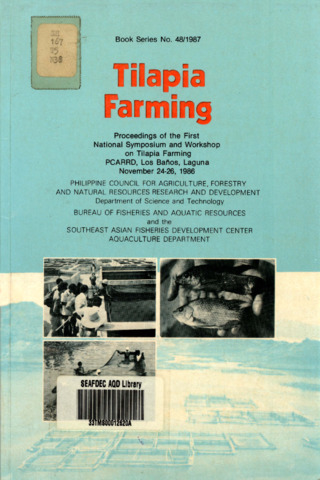Reproductive performance of four red tilapia strains in different seed production systems
| dc.contributor.author | Romana-Eguia, Maria Rowena R. | |
| dc.contributor.author | Eguia, Ruel V. | |
| dc.date.accessioned | 2024-12-02T08:46:29Z | |
| dc.date.available | 2024-12-02T08:46:29Z | |
| dc.date.issued | 1995 | |
| dc.identifier.citation | Romana-Eguia, M. R. R., & Eguia, R. V. (1995). Reproductive performance of four red tilapia strains in different seed production systems. Aquaculture, 137(1–4), 328. https://doi.org/10.1016/0044-8486(96)83586-1 | en |
| dc.identifier.issn | 0044-8486 | |
| dc.identifier.uri | http://hdl.handle.net/10862/6582 | |
| dc.description | Abstract only. | en |
| dc.description.abstract | Factors such as nutrition, season, sex ratio and broodstock density affect reproduction in red tilapias. However the extent by which genetic strain differences influence reproductive performance in red tilapias is not fully understood. Hence an experiment was conducted to compare the reproductive efficiency of three genetically diverse Philippine red tilapia strains (“BFS”, “FAC” and “PP’) and one imported Asian strain (“NIFI” from Bangkok, Thailand). Breeders (one male: four females) from each strain were tested in two types of fry production systems (2 m x 2 m x 1 m concrete tanks and lake based 2 m x 2 m x 1 m hapa net cages). Spawning activity, fecundity, and hatchability were monitored and recorded. Seed production in all strains were noted to be lower in cages than in tanks. Daily mean seed production per spawner in the land-based hatchery system was highest at 13.662 for NIFI followed by FAC ( 13.236), BFS (10.966), and PF (7.77). In the hapa net cages, the BFS strain produced 1.137 seeds per female daily while PF, NIFI and FAC gave daily harvests of 0.968, 0.773 and 0.517 seeds per spawner. Seed production was significantly influenced by the type of hatchery system (P = 0,000) , strain (P = 0,021) and strain x hatchery system (P = 0,007), No significant strain differences were found when spawning percentage and hatchability data were analysed. | en |
| dc.language.iso | en | en |
| dc.publisher | Elsevier | en |
| dc.subject | tilapia | en |
| dc.subject | egg hatchability | en |
| dc.title | Reproductive performance of four red tilapia strains in different seed production systems | en |
| dc.type | Article | en |
| dc.identifier.doi | 10.1016/0044-8486(96)83586-1 | |
| dc.citation.volume | 137 | en |
| dc.citation.issue | 1-4 | en |
| dc.citation.spage | 328 | en |
| dc.citation.journalTitle | Aquaculture | en |
| dc.subject.asfa | seed production | en |
| dc.subject.asfa | tilapia culture | en |
| dc.subject.asfa | sexual reproduction | en |
| dc.subject.asfa | aquaculture systems | en |
| dc.subject.asfa | spawning | en |
| dc.subject.asfa | fertility | en |
このアイテムのファイル
| ファイル | サイズ | フォーマット | 閲覧 |
|---|---|---|---|
|
このアイテムに関連するファイルは存在しません。 |
|||
このアイテムは次のコレクションに所属しています
-
Journal Articles [1256]
These papers were contributed by Department staff to various national and international journals.




